
Video SEO: The Complete Guide to Organic Video Traffic
When it comes to your video marketing strategy, there are a lot of moving parts to take into account besides for the video creation.
Too often, we find that even experienced marketers skip over one extremely important aspect of their video strategy – SEO.
You might be using video already as part of your advertising strategy to drive traffic from social media to your website, but we’re here to tell you that there’s way more to video than just social traffic – it’s a fundamental way to drive organic traffic.
Don’t freak out, I know what you’re thinking. Video SEO is too complicated – it’s basically a foreign language.
Well, that’s exactly why we wrote this comprehensive easy-to-follow guide on all things video SEO. We’ll hold your hand throughout the entire process, giving you step-by-step, actionable instructions.
You’ll quickly get the hang of the whole process and you’ll have perfectly-optimized videos in no time. Trust us, when you’re done with this article, you won’t understand why you were worried in the first place.
Let’s get to it!
What is Video SEO?
Before we start to tackle the more technical parts of video SEO, let’s start with a quick primer on the topic. Just to make sure we cover all of our bases, let’s break the term all the way into its individual components:
First: Video
In this case, we’re talking about video content of all types. From product videos to promo videos, tutorials, guides, and more. This guide applies to any type of video that you create and publish anywhere online.
Second: SEO
Search Engine Optimization (SEO) is about helping the right people find your content easily. Your content needs to be easy to find using search tools like Google, Bing, or the video search on YouTube. That means optimizing your content so that these search tools can understand what it’s about and then show it to users that search for relevant content.
So, what do we get if we combine the two?
Video SEO is the process of optimizing your video content so it can be easily discovered by your target audience through search sites and tools. In other words, it’s how you get your video in front of people who are searching for content like yours. (See, this is seeming more straightforward already, isn’t it?)
Okay, so now that we’ve got the basics covered, let’s dig into this a bit more.
We can basically break down SEO for videos into two main channels:
- YouTube
People find and discover videos online almost exclusively through these two platforms.
Disclaimer: Google does own YouTube, so while technically they are the same company, they are different websites and have some unique differences when it comes to SEO and user experience.
Video Search on YouTube
On YouTube, users can type anything they want into the search bar at the top of the page. And viola! They’re almost certainly a video on that topic. (Maybe millions of them!)
And viola! They’re almost certainly a video on that topic. (Maybe millions of them!)
Behind the scenes, YouTube looks through all of the videos on their site and tries to return the ones that it thinks match what the user is looking for. The results are then ranked and presented in an order based on relevancy.
So, your SEO goal for YouTube is to do everything that you can to make sure that your video shows up near the top of the search results. That means it will be seen by more people and it’s more likely to get clicked and watched. (That’s what we want!)
Video Search on Google
Google also plays a big role in how video is discovered and watched online. Of course, you can search for videos specifically using Google. But, many times, even if you’re not searching for video specifically, the top results also include videos if Google thinks that you prefer a video for that particular intent. For many queries, Google will show what’s known as a video carousel in the results. This is a collection of relevant videos that match the search.
For many queries, Google will show what’s known as a video carousel in the results. This is a collection of relevant videos that match the search.
Having a video result in the SERPs (search engine results pages) is an extra bonus because the distinct visual treatment of video results tend to boost the CTR (click-through rate), meaning the videos attract more attention and traffic from searchers.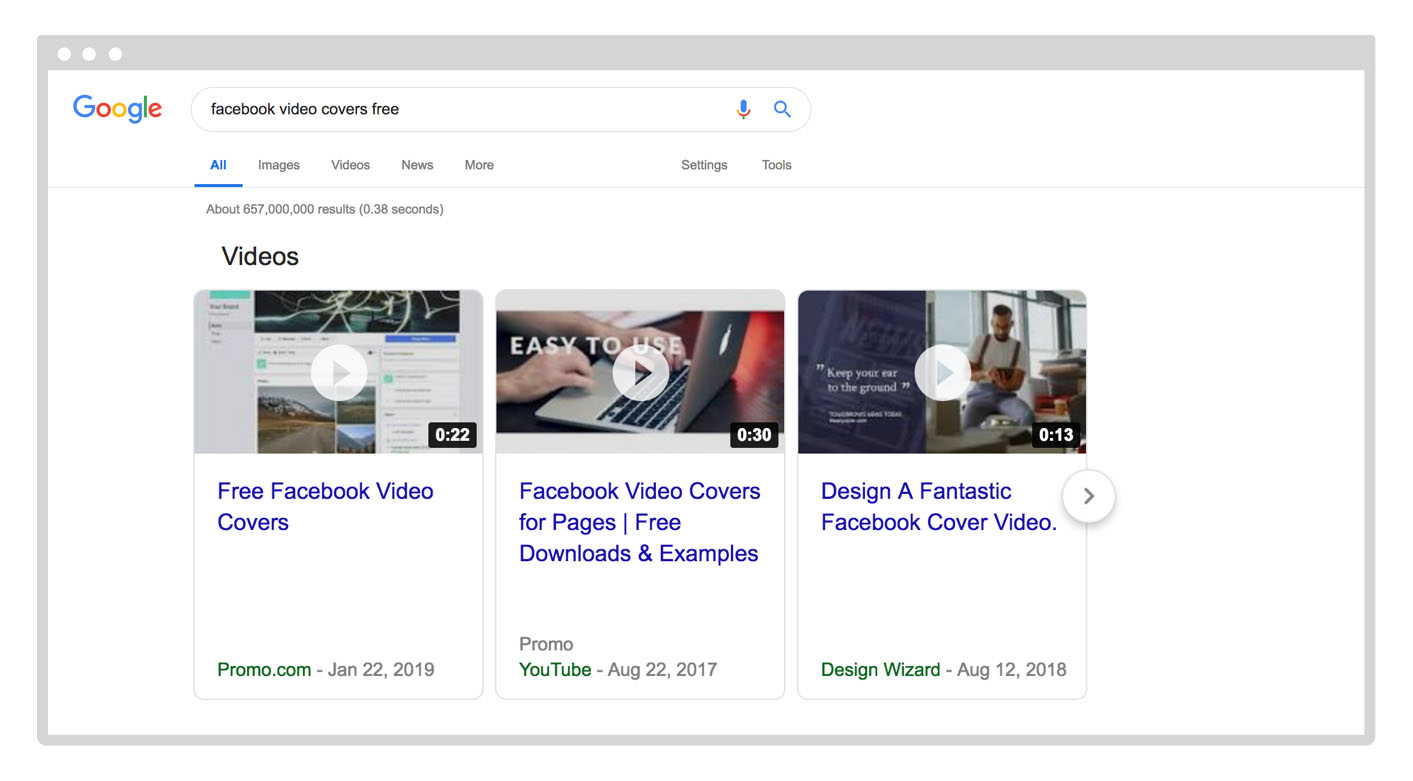 These video results can include YouTube videos, native video content, and also videos that are embedded within a content page.
These video results can include YouTube videos, native video content, and also videos that are embedded within a content page.
This means that when publishing video content, you want to optimize your video to be found by searchers on both YouTube and Google. That will help your video content get discovered and generate more views.
How videos can help with SEO and organic traffic
Organic traffic is a marketer’s favorite thing.
It’s traffic that comes from search engines without having to pay for it.
Not only is it basically “free” traffic to your website, but the people who are visiting your site were actively looking for that exact topic or content!
For most companies, content marketing is the key to a successful SEO strategy. Articles are written and published to help them rank for certain keywords that are relevant to their target audience, drawing in the right people to their site. It works and it’s great.
But it’s not just written content, video content also plays a critical role in SEO.
Video significantly contributes to your organic traffic by capturing new visitors who are specifically searching for video content.
By using video, your website can show up in more search results and generate more traffic than with just written content alone. For instance, if you publish a great article on a specific topic, it will only be discovered by users who are searching for web pages, but people who are specifically searching videos or using YouTube to find content on that topic will never see it.
That’s just not our opinion – even great SEO authorities such as Rand Fishkin and Eric Enge agree with us.
While Google search dominates the world of online search with 3.5 billion total searches conducted every day, YouTube is actually the second-most popular search site on the web. Over 3 billion searches happen on YouTube every month, which is more than Yahoo!, Bing, AOL, and Ask combined.
This alone makes video a huge benefit to your overall marketing strategy.
Video not only presents a significant contribution on its own but, incorporating video into your existing pages and written content can also help boost the SEO of those pages.
Adding rich content like video will make your content more comprehensive and keep search visitors engaged on your site and less likely to bounce (leave the site after viewing one page).
So, in addition to the new traffic that you can generate to your video content, adding video can actually boost your site-wide SEO for existing pages and written content.
That’s like a double whammy!
Now that we covered how valuable video SEO can be – how can we implement it?
Let’s walk through the process together.
Keyword Research for Videos: A step-by-step guide
The first step in successful Video SEO is keyword research.
Like doing your homework and studying before the big test, if you do it right, you have nothing to worry about and if you don’t do it, things may not go well – So let’s make sure we get it right!
What are keywords?
Keyword research tells us which terms users are most likely to type in when they’re looking for content on the topic that you’re covering.
For instance, say you’ve created a video on how to dress for success. You’ll want to be sure that when people search that topic, your video will be in the top results.
To make sure that happens, we have to address one big question mark.
When people are looking for videos on this topic, are they more likely to search for “how to dress for success”, “what clothes to wear to look successful”, “building an attire for success”, or some other phrase?
At this point, if you’ve never done keyword research before, you’re probably just shrugging your shoulders. How the heck should you know, right?
But, with a little bit of magic (read: “data”), we can figure it out together!
Just in case you’re curious about this specific case, here’s the answer: “Build your own computer” wins with an estimated 1,000 to 10,000 searches per month.
“Build your own computer” wins with an estimated 1,000 to 10,000 searches per month.
So, here’s what you need to do:
- Define who you want to target with your video content
- Come up with search terms/queries they would use to find your content
- Conduct keyword research to see which search terms/keywords are most popular
- From those keywords, choose the one(s) that are more relevant to your video
- Optimize your video for the best keyword(s)
How to conduct keyword research for Google
Let’s begin this process by performing keyword research for Google (like the example above).
Anyone who practices SEO knows that keyword data is one of the most essential ingredients for success. That’s exactly why there are tons of different tools that will help you find and evaluate keywords based on how frequently people are searching for them.
First, we’ll cover the classic, tried-and-true way to research keywords. Then we’ll cover a few other third-party tools.
Using Google Keyword Planner for SEO Keyword Research
Keyword Planner is the “official” keyword research tool, created by Google.
The best part about it that the tool is totally free! All you need is a Google account and a Google AdWords (now just called Google Ads) account.
Here’s how to get started:
- Open up Keyword Planner
- Brainstorm a few initial searches that you think may be relevant
- Type your keyword ideas into the box (separated by commas)
- Hit search
Begin by clicking the link above to open Keyword Planner. If you aren’t already logged in (or don’t have an AdWords account), it may ask you to go through a few quick steps to create one.
Once you log in or create your Google Ads account, you should see this screen: Go ahead and click Tools > Keyword Planner to open it up.
Go ahead and click Tools > Keyword Planner to open it up.
Click “Find new keywords”. Then, type in some initial keyword ideas and hit “Get started”: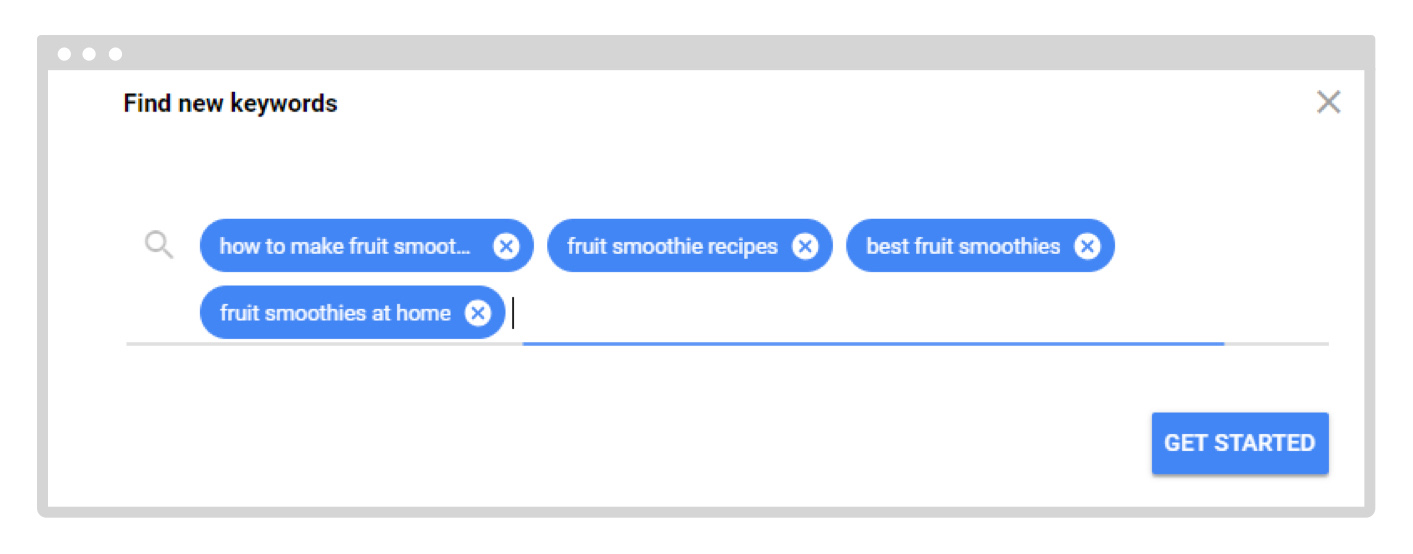 You’ll get back data on the keywords that you put in, along with some suggested variations that may actually be better than your original ideas!
You’ll get back data on the keywords that you put in, along with some suggested variations that may actually be better than your original ideas!
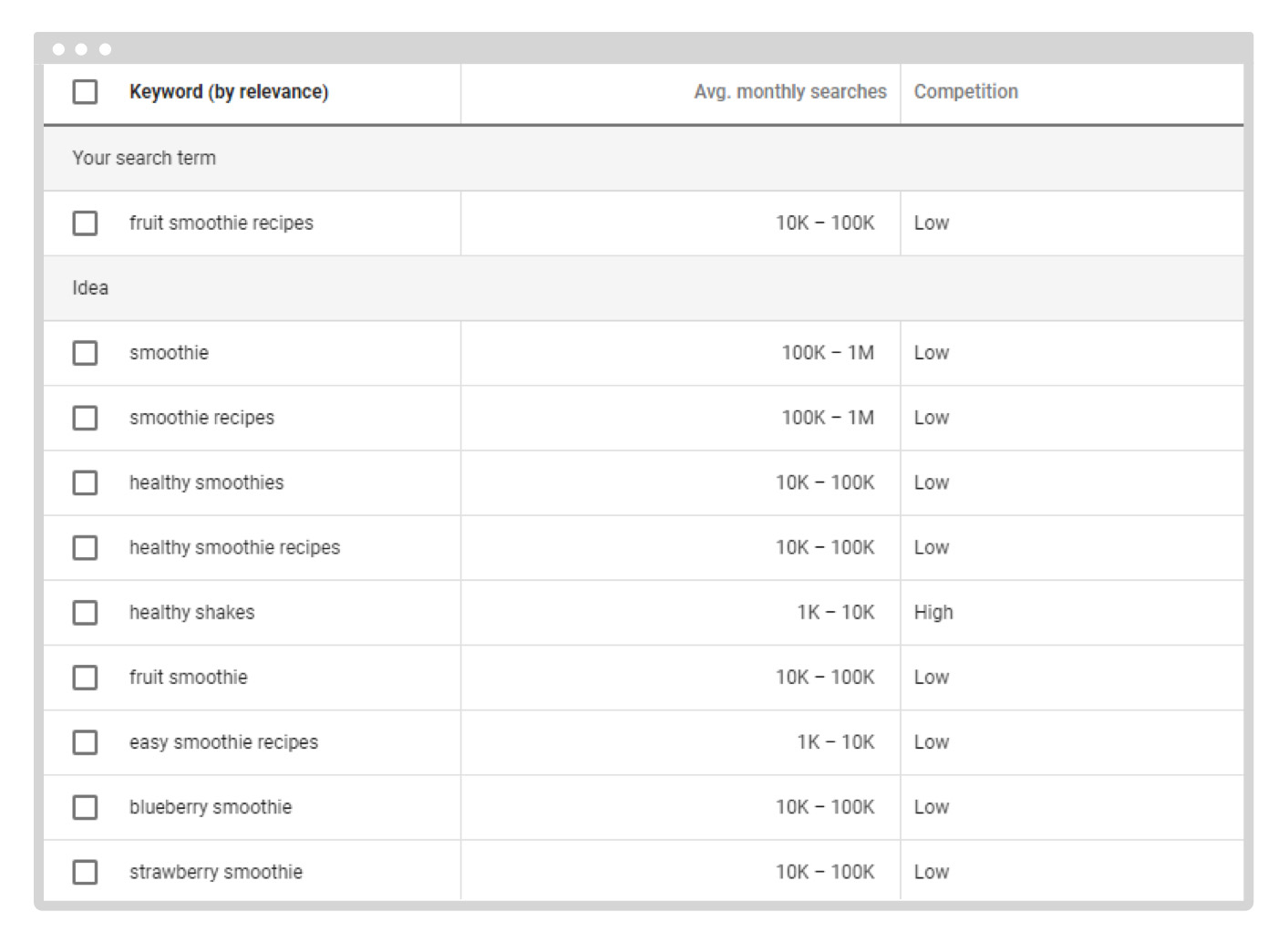 Feel free to run the search multiple times, adding in new keyword ideas or variations. This will provide more thorough results.
Feel free to run the search multiple times, adding in new keyword ideas or variations. This will provide more thorough results.
When you find the keywords that you like and may want to target, you can add them to your list. We’d suggest just opening up a spreadsheet or document and taking note of important keywords.
If you want to compile all of the data or look at it later, you can use the “Download” option to save a spreadsheet with all of the keywords from your current search.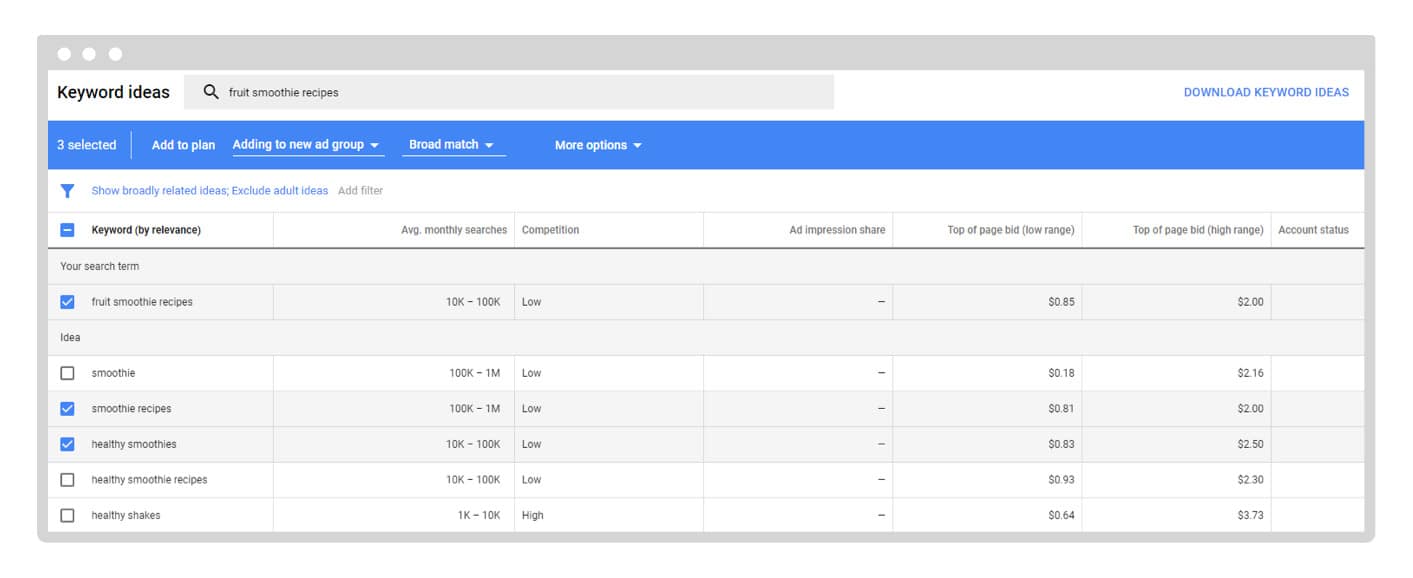
Pro tip: Before deciding on any specific keywords to target, try doing a quick Google search for that term. Do any videos show up in the top results? If not, then you may want to choose a different keyword. You probably don’t want to optimize your video content for a keyword if your video may never actually show up.
If not, then you may want to choose a different keyword. You probably don’t want to optimize your video content for a keyword if your video may never actually show up.
Here’s a short list of other keyword research tools for you to check out:
How to conduct keyword research for YouTube
We now have some initial keyword ideas based on Google data. But, this is only half of the process. The way that users use Google and YouTube is different, so you’ll want to try researching both to see which terms are relevant for both Google and YouTube users.
The process of finding keywords for YouTube is a bit different.
First of all, the data and tools at your disposal are more limited. Other than Google/Youtube, no one has any exact information on how many people search for a given term and there’s no such thing as a “Keyword Planner” tool specifically for YouTube.
But don’t be discouraged! We can do some clever sleuthing to figure out which keywords to target.
You can also check out the third-party tools below to do more sophisticated research down the road.
Using YouTube auto-suggest feature
The best and simplest way to identify keywords that might be relevant for your video is to use YouTube’s auto-suggest feature.
This process is very simple:
- Go to YouTube
- In the search bar, type the first few letters or words of a keyword
- Use the autocomplete feature to help you find keywords
- Repeat for several variations
- Create a list of relevant searches from the autocomplete
Just like on Google, when you type something into the search bar at the top of the page, YouTube will generate a list of suggested searches that may be relevant to you.  Although you don’t get any specific data on those keywords (like search volume), we can safely assume that YouTube’s auto-suggest algorithm is likely showing you the most relevant and popular searches first.
Although you don’t get any specific data on those keywords (like search volume), we can safely assume that YouTube’s auto-suggest algorithm is likely showing you the most relevant and popular searches first.
From this list, you can quickly compile searches that may be relevant and use these to optimize your video content.
Here are some other keyword tools that can help:
Combining Google and YouTube keywords
The last step in this process is to combine the keywords that you found from the Google Keyword Planner with the keywords that YouTube suggested in their search bar.
Together, this should give you a representative sample of which keywords are likely to be relevant to your video content and how you should optimize when posting your video.
Begin this process by putting the keywords side by side. Compare them to see which keywords showed up in both searches. If they’re relevant to your video (or you can create a video that is relevant), then these would likely be a good place to start, so target those keywords first.
Once you have your target keywords in hand, it’s time to get to work!
Video hosting: Choosing where your video lives
Before we get into optimizing your video, you’ll first need to decide how you’ll publish and share your video content online. This will determine which factors are relevant for you when strategizing your video SEO.
Basically, you have two options:
- Self-hosted video
- Publish through a video platform
To help you decide which one is right for you, let’s break down the pros and cons.
Option #1: Self-hosted video
If you want to keep your video content entirely hosted and housed on your own website, you can do that.
What this means is that you’ll embed the video directly into your content pages just like an image, using specific markup that allows you to choose where the video appears on your site.
While self-hosted video can be found by Google, it won’t appear at all on YouTube or other video sites and platforms. That’s one of the reasons many people choose to publish their videos through an established platform.
Wistia is one tool that will make it easier for you to host videos and serve them up on-demand.
There aren’t a lot of benefits to using a self-host option, except that your videos will live 100% on your own website and you won’t have people watching them on YouTube. In theory, this could be beneficial because YouTube viewers may never go from your video to your website. So, by keeping any video traffic 100% on your own website, you may actually get more meaningful traffic than you would generate by getting more views from YouTube.
Option #2: Publish your video on YouTube (or other video platforms)
The second and most common solution is to use existing platforms to host your video.
Obviously, the leader here is YouTube. More than 300 hours of video content are uploaded every single minute. It’s not a surprise, because it’s a simple solution that allows you to easily publish content and get your video in front of the huge number of people who use YouTube (and Google) every single day.
You can also look at sites like Vimeo, which offer an alternative solution to YouTube, but many of the same features.
Pros and cons: Self-hosted video vs. YouTube or Vimeo
Let’s compare these two options at a glance:
Optimizing Video for SEO
Now that we’ve covered all of the preliminary decisions and research, let’s get to the actual work and start optimizing your videos.
Believe it or not, if you’ve gone through the above process, then the actual optimization part is incredibly easy. In fact, depending on how you choose to host your video, it may just mean doing a tiny bit of extra writing!
First, let’s start by taking the target keyword(s) you identified above. The steps you need to take will depend on whether you’re self-hosting your video or publishing it via YouTube.
What exactly does “optimizing” mean?
It simply means that you include the keywords that you want to target within the copy that you’re writing. You don’t need to go crazy, repeating the keyword over and over again. Instead, write naturally, while making sure to integrate the keyword you want.
Optimizing videos on YouTube
If you’re planning to publish your video via YouTube, there are 4 basic text elements that you need to make sure you optimize.
- Video title
- Video description
- Video script/transcript
- Video tags
- Video title
The video title should include the keywords you’re trying to target. You can get creative, but try to keep the key phrase as close to your target as possible.
- Video description
Write a detailed video description that helps signal to YouTube and Google what is included in your video. It’s generally best to write a 200-word description at minimum.
- Video script/transcript
Whether you upload a transcript or not, YouTube will generate a transcript for your video. That means that it’s actually important for you to make sure that the language used within the video fits with the keyword(s) that you want to target. In addition, it’s usually best practice to upload a transcript rather than let YouTube generate one automatically!
- Video tags
Last, but not least, be sure to use relevant tags on your video. Although the user does not see these and they are not used as a “ranking signal”, it’s still best practice to include several relevant tags to help YouTube understand your content and what it’s about.
Optimizing self-hosted video
When it comes to optimizing your self-hosted video, you’ll need to do some of the technical heavy lifting that is already handled by YouTube.
You’ll want to pay attention to a few different things that will help Google to crawl your website, understand your content, and figure out when and where to rank your videos.
- On-page optimization
- Schema markup
- Video sitemap
Let’s dig in with a bit more detail.
- On-page optimization
First things first – All SEO is about optimizing your content for the user and to help search engines understand the topic.
When it comes to video SEO, it’s no different.
If you’re self-hosting the video, then you want to make sure that you embed that video on a page that is entirely optimized for the keywords that you’re targeting for the video itself. That means getting all of the on-page optimization pieces in place.
- Title tag
- Metadata
- Heading tags
- Written content
Best practice here is to create a specific content page for the keyword you want to target. Optimize all of the on-page elements for the keyword. Then, include your video within the body of that page (usually toward the top works best).
This will help Google associate your actual video (the file itself) with the written content that’s on the page.
- Schema markup
In addition to basic on-page optimization, you’ll need to do a bit more to make sure that search engines are able to crawl and rank your video pages.
One important thing is the video schema markup.
The schema markup is code that can be added to the header of your website to tell Google how to interpret the video on your page and helps it decide where to index the video in the search results.
I won’t cover all of the nerdy technical details here, but, Google has a simple guide that can help you set this up.
- Video sitemap
Lastly, you should consider including a separate video sitemap for your site.
If you’re not familiar with sitemaps, they’re basically organized lists of all of the pages on your website. It’s helpful to submit these to Google directly to help them find and index all of the pages on your site. Likewise, you can submit a video sitemap to make sure that they find all of your video content and index it for search.
Google has a guide on creating and submitting video sitemaps for your website.
How video quality and content affects SEO
While you have all of the basics covered for on-page and YouTube video optimization, remember that this is all really just the table stakes for getting your video to rank well in search.
Ultimately, Google and YouTube want to show the best and most relevant videos to their users. This means that they also measure the quality and engagement of the video.
In plain English: The better your video content and quality, the more engagement it generates, and the higher your rankings climb.
Google and YouTube can see how many people see the video, how many watch it, how long they watch it for, if the video has received more positive or negative responses, and all kinds of other data.
Then, they can use that to decide how much people like your videos.
It might go without saying, but creating really good video content is an important part of achieving high search rankings. We’ve written many articles on the best practices for creating engaging videos that are more likely to achieve high rankings.
But, for this post, we’ll cover some of the basic strategies to take into account to signal quality content and hopefully improve search rankings.
- Consider creating longer videos
While short, snappy, and engaging videos work wonders on social, it may not be the best approach for ranking in search engines.
Because one of the metrics that signal quality is the average watch time, having a longer video creates more opportunity for users to watch the video for longer. For instance, if you create two videos and one is 2 minutes while the other video is 10, then even if every viewer watches the entire first video, the average watch time can only be 2 minutes maximum. But on the flip side, if users watch just 50% of video #2, on average, then the watch time is 5 minutes–viewers seem to be more engaged and it’s likely to drive better rankings.
- Create a CTA within the video and description
When it comes to video, never be shy about asking your users to take action.
Other ways that Google and YouTube assess the quality of your content is by how many people like, comment, share, subscribe, or thumbs-up the video and the best way to get more people to take those actions is to simply ask them!
Take a few moments in your video to explicitly ask the viewer to take action. Then also consider adding a repeated call to action in the description or any surrounding content if the video is hosted on your website.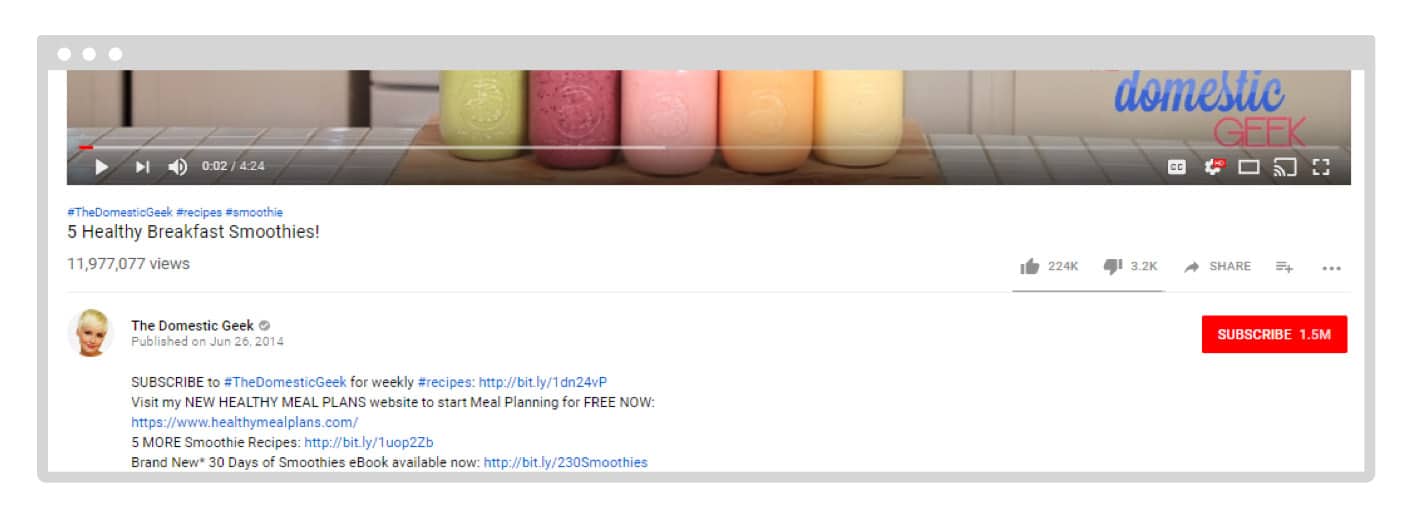
- Keep the content interesting
If you want to create awesome videos, focus on making the video content interesting and keeping the viewer engaged! That can seem like a vague suggestion, but there are many practical and tactical ways that you can put this to use.
Here are some things that can help you hook a viewer, keep them engaged, and boost your SEO:
- Focus on hooking the viewer within the first 15 seconds (or sooner!)
- Use music to add depth and make the video more engaging
- Add transitions, animations, and other effects
- Throw in fun surprises or unexpected elements to keep viewers looking for the next exciting moment
How to get started with video
Alright, we covered a lot of ground today. Hopefully, you now see that video SEO is a big topic, but when you break it down, it’s really not all that complicated.
Are you ready to get started creating optimized videos that drive organic traffic?
Begin by conducting keyword research as outlined above.
If you already have videos created, search for keywords that are a fit and make sense to target for the content that you already have on hand.
If you haven’t created any video content yet, then start with your keyword research data and use that to steer what videos you do create. Which topics are most popular? What content can you create that fills a need people are actively searching for? Then head to our video maker to create videos that resonate with your audience and align with your seo research.
With keyword data and solid optimization, you can accomplish anything.






